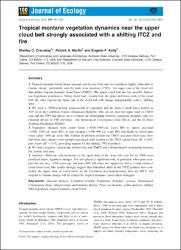| Author | Crausbay, Shelley D. | |
| Author | Martin, Patrick H. | |
| Author | Kelly, Eugene F. | |
| Accessioned date | 2024-01-04T19:49:44Z | |
| Available date | 2024-01-04T19:49:44Z | |
| Year | 2022 | |
| Citation | Crausbay, S. D., Martin, P. H., & Kelly, E. F. (2015). Tropical montane vegetation dynamics near the upper cloud belt strongly associated with a shifting ITCZ and fire. Journal of Ecology, 103(4), 891-903. Recuperado de: | es |
| URI | https://bvearmb.do/handle/123456789/3834 | |
| Abstract | Tropical montane forests house unusual and diverse biota and are considered highly vulnerable to climate change, particularly near the trade wind inversion (TWI) – the upper end of the cloud belt that defines tropical montane cloud forest (TMCF). The upper cloud belt has two possible futures: one hypothesis postulates a ‘lifting cloud base’, raising both the upper and lower ends of the cloud belt; the other expects the upper end of the cloud belt will change independently, with a ‘shifting TWI’. We used a ˜5900-year-long palaeorecord of vegetation and fire from a small forest hollow at 2455 m in the Cordillera Central, Dominican Republic. The site sits near the upper limit of TMCF taxa and the TWI and allows us to evaluate the relationship between vegetation dynamics and two potential drivers of TWI elevation – the Intertropical Convergence Zone (ITCZ) and the El Niño/Southern Oscillation (ENSO). | es |
| Language | English | es |
| Published | Journal of Ecology, 103(4), 891-903 | es |
| Rights | © 2015 The Authors. ©2015 British Ecological Society. | es |
| Subject | Recursos naturales - República Dominicana | es |
| Subject | Recursos forestales | es |
| Subject | Incendios forestales | es |
| Subject | Cambio climático | es |
| Title | Tropical montane vegetation dynamics near the upper cloud belt strongly associated with a shifting ITCZ and fire | es |
| dc.identifier.doi | https://doi.org/10.1111/1365-2745.12423 | |
| Material type | Article | es |
| Type of content | Scientific research | es |
| Access | Open | es |
| Audience | Technicians, professionals and scientists | es |


